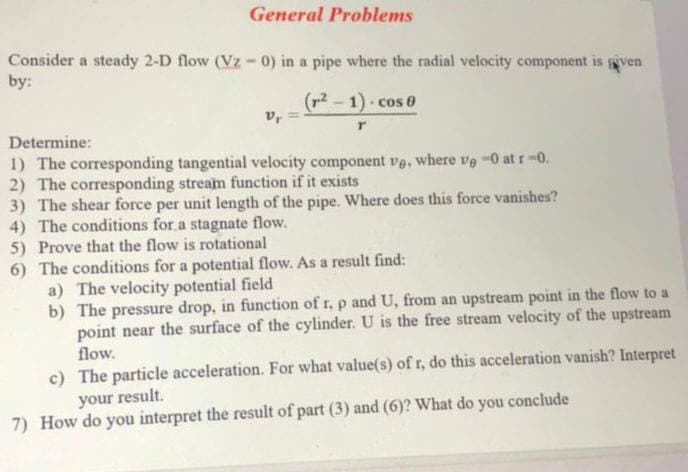General Problems Consider a steady 2-D flow (Vz-0) in a pipe where the radial velocity component is ven by: (r2-1) cos 0 Determine: 1) The corresponding tangential velocity component ve, where ve -0 at r-0. 2) The corresponding stream function if it exists 3) The shear force per unit length of the pipe. Where does this force vanishes? ditione for a stagnate flow
General Problems Consider a steady 2-D flow (Vz-0) in a pipe where the radial velocity component is ven by: (r2-1) cos 0 Determine: 1) The corresponding tangential velocity component ve, where ve -0 at r-0. 2) The corresponding stream function if it exists 3) The shear force per unit length of the pipe. Where does this force vanishes? ditione for a stagnate flow
Elements Of Electromagnetics
7th Edition
ISBN:9780190698614
Author:Sadiku, Matthew N. O.
Publisher:Sadiku, Matthew N. O.
ChapterMA: Math Assessment
Section: Chapter Questions
Problem 1.1MA
Related questions
Question
i need the answer quickly

Transcribed Image Text:General Problems
Consider a steady 2-D flow (Vz - 0) in a pipe where the radial velocity component is gven
by:
(p2 - 1) cos 0
vr
Determine:
1) The corresponding tangential velocity component ve, where ve -0 at r-0.
2) The corresponding stream function if it exists
3) The shear force per unit length of the pipe. Where does this force vanishes?
4) The conditions for.a stagnate flow.
5) Prove that the flow is rotational
6) The conditions for a potential flow. As a result find:
a) The velocity potential field
b) The pressure drop, in function of r, p and U, from an upstream point in the flow to a
point near the surface of the cylinder. U is the free stream velocity of the upstream
flow.
c) The particle acceleration. For what value(s) of r, do this acceleration vanish? Interpret
your result.
7) How do you interpret the result of part (3) and (6)? What do you conclude
Expert Solution
This question has been solved!
Explore an expertly crafted, step-by-step solution for a thorough understanding of key concepts.
This is a popular solution!
Trending now
This is a popular solution!
Step by step
Solved in 3 steps with 3 images

Knowledge Booster
Learn more about
Need a deep-dive on the concept behind this application? Look no further. Learn more about this topic, mechanical-engineering and related others by exploring similar questions and additional content below.Recommended textbooks for you

Elements Of Electromagnetics
Mechanical Engineering
ISBN:
9780190698614
Author:
Sadiku, Matthew N. O.
Publisher:
Oxford University Press

Mechanics of Materials (10th Edition)
Mechanical Engineering
ISBN:
9780134319650
Author:
Russell C. Hibbeler
Publisher:
PEARSON

Thermodynamics: An Engineering Approach
Mechanical Engineering
ISBN:
9781259822674
Author:
Yunus A. Cengel Dr., Michael A. Boles
Publisher:
McGraw-Hill Education

Elements Of Electromagnetics
Mechanical Engineering
ISBN:
9780190698614
Author:
Sadiku, Matthew N. O.
Publisher:
Oxford University Press

Mechanics of Materials (10th Edition)
Mechanical Engineering
ISBN:
9780134319650
Author:
Russell C. Hibbeler
Publisher:
PEARSON

Thermodynamics: An Engineering Approach
Mechanical Engineering
ISBN:
9781259822674
Author:
Yunus A. Cengel Dr., Michael A. Boles
Publisher:
McGraw-Hill Education

Control Systems Engineering
Mechanical Engineering
ISBN:
9781118170519
Author:
Norman S. Nise
Publisher:
WILEY

Mechanics of Materials (MindTap Course List)
Mechanical Engineering
ISBN:
9781337093347
Author:
Barry J. Goodno, James M. Gere
Publisher:
Cengage Learning

Engineering Mechanics: Statics
Mechanical Engineering
ISBN:
9781118807330
Author:
James L. Meriam, L. G. Kraige, J. N. Bolton
Publisher:
WILEY